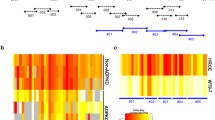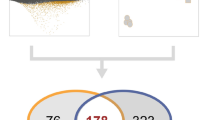Abstract
Autosomal dominant polycystic kidney disease (ADPKD) is a common human genetic disease characterized by the formation of multiple fluid-filled cysts in bilateral kidneys. Although mutations in polycystic kidney disease 1 (PKD1) are predominantly responsible for ADPKD, the focal and sporadic property of individual cystogenesis suggests another molecular mechanism such as epigenetic alterations. To determine the epigenomic alterations in ADPKD and their functional relevance, ADPKD and non-ADPKD individuals were analyzed by unbiased methylation profiling genome-wide and compared with their expression data. Intriguingly, PKD1 and other genes related to ion transport and cell adhesion were hypermethylated in gene-body regions, and their expressions were downregulated in ADPKD, implicating epigenetic silencing as the key mechanism underlying cystogenesis. Especially, in patients with ADPKD, PKD1 was hypermethylated in gene-body region and it was associated with recruitment of methyl-CpG-binding domain 2 proteins. Moreover, treatment with DNA methylation inhibitors retarded cyst formation of Madin-Darby Canine Kidney cells, accompanied with the upregulation of Pkd1 expression. These results are consistent with previous studies that knock-down of PKD1 was sufficient for cystogenesis. Therefore, our results reveal a critical role for hypermethylation of PKD1 and cystogenesis-related regulatory genes in cyst development, suggesting epigenetic therapy as a potential treatment for ADPKD.








Similar content being viewed by others
References
Abdul-Majeed S, Nauli SM (2011) Calcium-mediated mechanisms of cystic expansion. Biochim Biophys Acta 1812:1281–1290
Aran D, Toperoff G, Rosenberg M, Hellman A (2011) Replication timing-related and gene body-specific methylation of active human genes. Hum Mol Genet 20:670–680
Ariel M, Robinson E, McCarrey JR, Cedar H (1995) Gamete-specific methylation correlates with imprinting of the murine Xist gene. Nat Genet 9:312–315
Badenas C, Torra R, Perez-Oller L, Mallolas J, Talbot-Wright R, Torregrosa V, Darnell A (2000) Loss of heterozygosity in renal and hepatic epithelial cystic cells from ADPKD1 patients. Eur J Hum Genet 8:487–492
Boletta A, Qian F, Onuchic LF, Bhunia AK, Phakdeekitcharoen B, Hanaoka K, Guggino W, Monaco L, Germino GG (2000) Polycystin-1, the gene product of PKD1, induces resistance to apoptosis and spontaneous tubulogenesis in MDCK cells. Mol Cell 6:1267–1273
Brasier JL, Henske EP (1997) Loss of the polycystic kidney disease (PKD1) region of chromosome 16p13 in renal cyst cells supports a loss-of-function model for cyst pathogenesis. J Clin Invest 99:194–199
Chapin HC, Caplan MJ (2010) The cell biology of polycystic kidney disease. J Cell Biol 191:701–710
Choi JK (2010) Contrasting chromatin organization of CpG islands and exons in the human genome. Genome Biol 11:R70
Choi JK, Bae JB, Lyu J, Kim TY, Kim YJ (2009) Nucleosome deposition and DNA methylation at coding region boundaries. Genome Biol 10:R89
Dalgin GS, Drever M, Williams T, King T, DeLisi C, Liou LS (2008) Identification of novel epigenetic markers for clear cell renal cell carcinoma. J Urol 180:1126–1130
Deaton AM, Webb S, Kerr AR, Illingworth RS, Guy J, Andrews R, Bird A (2011) Cell type-specific DNA methylation at intragenic CpG islands in the immune system. Genome Res 21:1074–1086
Dennis G Jr, Sherman BT, Hosack DA, Yang J, Gao W, Lane HC, Lempicki RA (2003) DAVID: database for annotation, visualization, and integrated discovery. Genome Biol 4:P3
Feinberg AP, Tycko B (2004) The history of cancer epigenetics. Nat Rev Cancer 4:143–153
Furukawa T, Morrow EM, Cepko CL (1997) Crx, a novel otx-like homeobox gene, shows photoreceptor-specific expression and regulates photoreceptor differentiation. Cell 91:531–541
Gabow PA (1993) Autosomal dominant polycystic kidney disease. N Engl J Med 329:332–342
Grantham JJ (1996) The etiology, pathogenesis, and treatment of autosomal dominant polycystic kidney disease: recent advances. Am J Kidney Dis 28:788–803
Harris PC, Rossetti S, Consugar MB, Chapman AB, Torres VE, Guay-Woodford LM, Grantham JJ, Bennett WM, Meyers CM, Walker DL, Bae K, Zhang QJ, Thompson PA, Miller JP (2007) Comprehensive molecular diagnostics in autosomal dominant polycystic kidney disease. J Am Soc Nephrol 18:2143–2160
Ibraghimov-Beskrovnaya O, Bukanov N (2008) Polycystic kidney diseases: from molecular discoveries to targeted therapeutic strategies. Cell Mol Life Sci 65:605–619
Jiang ST, Chiou YY, Wang E, Lin HK, Lin YT, Chi YC, Wang CK, Tang MJ, Li H (2006) Defining a link with autosomal-dominant polycystic kidney disease in mice with congenitally low expression of Pkd1. Am J Pathol 168:205–220
Jones PA, Baylin SB (2007) The epigenomics of cancer. Cell 128:683–692
Kaslow DC, Migeon BR (1987) DNA methylation stabilizes X chromosome inactivation in eutherians but not in marsupials: evidence for multistep maintenance of mammalian X dosage compensation. Proc Natl Acad Sci USA 84:6210–6214
Kioussi C, Briata P, Baek SH, Rose DW, Hamblet NS, Herman T, Ohgi KA, Lin C, Gleiberman A, Wang J, Brault V, Ruiz-Lozano P, Nguyen HD, Kemler R, Glass CK, Wynshaw-Boris A, Rosenfeld MG (2002) Identification of a Wnt/Dvl/beta-Catenin → Pitx2 pathway mediating cell-type-specific proliferation during development. Cell 111:673–685
Koptides M, Constantinides R, Kyriakides G, Hadjigavriel M, Patsalis PC, Pierides A, Deltas CC (1998) Loss of heterozygosity in polycystic kidney disease with a missense mutation in the repeated region of PKD1. Hum Genet 103:709–717
Koptides M, Mean R, Demetriou K, Pierides A, Deltas CC (2000) Genetic evidence for a trans-heterozygous model for cystogenesis in autosomal dominant polycystic kidney disease. Hum Mol Genet 9:447–452
Kretzler M, Allred L (2008) Notch inhibition reverses kidney failure. Nat Med 14:246–247
Lantinga-van Leeuwen IS, Dauwerse JG, Baelde HJ, Leonhard WN, van de Wal A, Ward CJ, Verbeek S, DeRuiter MC, Breuning MH, de Heer E, Peters DJM (2004) Lowering of Pkd1 expression is sufficient to cause polycystic kidney disease. Hum Mol Genet 13:3069–3077
Li X (2011) Epigenetics and autosomal dominant polycystic kidney disease. Biochim Biophys Acta 1812:1213–1218
Lister R, Pelizzola M, Dowen RH, Hawkins RD, Hon G, Tonti-Filippini J, Nery JR, Lee L, Ye Z, Ngo QM, Edsall L, Antosiewicz-Bourget J, Stewart R, Ruotti V, Millar AH, Thomson JA, Ren B, Ecker JR (2009) Human DNA methylomes at base resolution show widespread epigenomic differences. Nature 462:315–322
Loghman-Adham M, Nauli SM, Soto CE, Kariuki B, Zhou J (2003) Immortalized epithelial cells from human autosomal dominant polycystic kidney cysts. Am J Physiol Renal Physiol 285:F397–F412
Muotri AR, Marchetto MC, Coufal NG, Oefner R, Yeo G, Nakashima K, Gage FH (2010) L1 retrotransposition in neurons is modulated by MeCP2. Nature 468:443–446
Park EY, Sung YH, Yang MH, Noh JY, Park SY, Lee TY, Yook YJ, Yoo KH, Roh KJ, Kim I, Hwang YH, Oh GT, Seong JK, Ahn C, Lee HW, Park JH (2009) Cyst formation in kidney via B-Raf signaling in the PKD2 transgenic mice. J Biol Chem 284:7214–7222
Park EY, Woo YM, Park JH (2011a) Polycystic kidney disease and therapeutic approaches. BMB Rep 44:359–368
Park JH, Park J, Choi JK, Lyu J, Bae MG, Lee YG, Bae JB, Park DY, Yang HK, Kim TY, Kim YJ (2011b) Identification of DNA methylation changes associated with human gastric cancer. BMC Med Genomics 4:82
Pei Y, Paterson AD, Wang KR, He N, Hefferton D, Watnick T, Germino GG, Parfrey P, Somlo S, St. George-Hyslop P (2001) Bilineal disease and trans-heterozygotes in autosomal dominant polycystic kidney disease. Am J Hum Genet 68:355–363
Qian F, Watnick TJ, Onuchic LF, Germino GG (1996) The molecular basis of focal cyst formation in human autosomal dominant polycystic kidney disease type I. Cell 87:979–987
Rauch T, Li H, Wu X, Pfeifer GP (2006) MIRA-assisted microarray analysis, a new technology for the determination of DNA methylation patterns, identifies frequent methylation of homeodomain-containing genes in lung cancer cells. Cancer Res 66:7939–7947
Sakamoto Y, Watanabe S, Ichimura T, Kawasuji M, Koseki H, Baba H, Nakao M (2007) Overlapping roles of the methylated DNA-binding protein MBD1 and polycomb group proteins in transcriptional repression of HOXA genes and heterochromatin foci formation. J Biol Chem 282:16391–16400
Song X, Di Giovanni V, He N, Wang K, Ingram A, Rosenblum ND, Pei Y (2009) Systems biology of autosomal dominant polycystic kidney disease (ADPKD): computational identification of gene expression pathways and integrated regulatory networks. Hum Mol Genet 18:2328–2343
Surendran K, Selassie M, Liapis H, Krigman H, Kopan R (2010) Reduced Notch signaling leads to renal cysts and papillary microadenomas. J Am Soc Nephrol 21:819–832
Thomson JP, Skene PJ, Selfridge J, Clouaire T, Guy J, Webb S, Kerr AR, Deaton A, Andrews R, James KD, Turner DJ, Illingworth R, Bird A (2010) CpG islands influence chromatin structure via the CpG-binding protein Cfp1. Nature 464:1082–1086
Tomaskovic-Crook E, Thompson EW, Thiery JP (2009) Epithelial to mesenchymal transition and breast cancer. Breast Cancer Res 11:213
Torres VE, Boletta A, Chapman A, Gattone V, Pei Y, Qian Q, Wallace DP, Weimbs T, Wuthrich RP (2010) Prospects for mTOR inhibitor use in patients with polycystic kidney disease and hamartomatous diseases. Clin J Am Soc Nephrol 5:1312–1329
Tost J, Gut IG (2007) DNA methylation analysis by pyrosequencing. Nat Protoc 2:2265–2275
Vasyutina E, Treier M (2010) Molecular mechanisms in renal degenerative disease. Semin Cell Dev Biol 21:831–837
Wolf G, Ritz E (2005) Combination therapy with ACE inhibitors and angiotensin II receptor blockers to halt progression of chronic renal disease: pathophysiology and indications. Kidney Int 67:799–812
Zheleznova NN, Wilson PD, Staruschenko A (2011) Epidermal growth factor-mediated proliferation and sodium transport in normal and PKD epithelial cells. Biochim Biophys Acta 1812:1301–1313
Acknowledgments
This research was supported by grants from the Korean Ministry of Science and Technology to Y-J.K (Global Research Lab). This work was also supported by the Bio & Medical Technology Development Program of the NRF (2012M3A9D1054518 and 2010-0019867). The authors declare no competing financial interests. Human kidney tissues of RCC and ADPKD patients were obtained from Dr. Curie Ahn at Department of Nephrology in Seoul National University Hospital. Histology of human normal and ADPKD kidney tissues was analyzed by professor Duk-Hee Kang at Department of Nephrology in Ewha Woman’s University.
Author information
Authors and Affiliations
Corresponding authors
Additional information
Y. M. Woo and J.-B. Bae contributed equally to this work.
Electronic supplementary material
Below is the link to the electronic supplementary material.
Rights and permissions
About this article
Cite this article
Woo, Y.M., Bae, JB., Oh, YH. et al. Genome-wide methylation profiling of ADPKD identified epigenetically regulated genes associated with renal cyst development. Hum Genet 133, 281–297 (2014). https://doi.org/10.1007/s00439-013-1378-0
Received:
Accepted:
Published:
Issue Date:
DOI: https://doi.org/10.1007/s00439-013-1378-0




